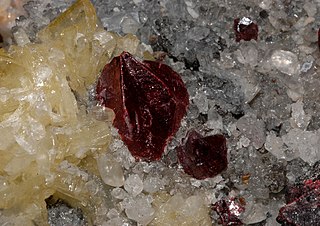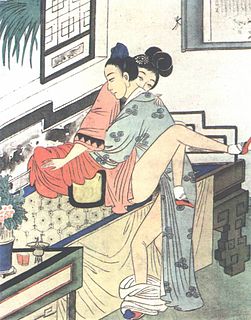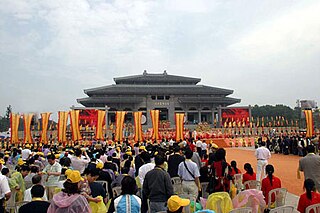
The Tao Te Ching, also known as Lao Tzu or Laozi, is a Chinese classic text traditionally credited to the 6th-century BC sage Laozi. The text's authorship, date of composition and date of compilation are debated. The oldest excavated portion dates back to the late 4th century BC, but modern scholarship dates other parts of the text as having been written—or at least compiled—later than the earliest portions of the Zhuangzi.

Taoism, or Daoism, is a philosophical tradition of Chinese origin which emphasizes living in harmony with the Tao. The Tao is a fundamental idea in most Chinese philosophical schools; in Taoism, however, it denotes the principle that is the source, pattern and substance of everything that exists. Taoism differs from Confucianism by not emphasizing rigid rituals and social order, but is similar in the sense that it is a teaching about the various disciplines for achieving "perfection" by becoming one with the unplanned rhythms of the universe called "the way" or "tao." Taoist ethics vary depending on the particular school, but in general tend to emphasize wu wei, "naturalness", simplicity, spontaneity and the Three Treasures: 慈, "compassion", 儉, "frugality" and 不敢為天下先, "humility".

Lao Tzu, also rendered as Laozi and Lao-Tze, was an ancient Chinese philosopher and writer. He is the reputed author of the Tao Te Ching, the founder of philosophical Taoism, and a deity in religious Taoism and traditional Chinese religions.

Li Tieguai is a Chinese mythological figure and one of the Eight Immortals in the Taoist pantheon. He is sometimes described as irascible and ill-tempered, but also benevolent to the poor, sick and the needy, whose suffering he alleviates with special medicine from his gourd. He is often portrayed as an ugly old man with dirty face, scraggy beard, and messy hair held by a golden band. He walks with the aid of an iron crutch and often has a gourd slung over his shoulder or held in his hand. He often is depicted as a clown figure who descends to earth in the form of a beggar who uses his power to fight for the oppressed and needy.

The Three Pure Ones, also translated as the Three Pure Pellucid Ones, the Three Pristine Ones, the Three Divine Teachers, the Three Clarities, or the Three Purities, are the Taoist Trinity, the three highest Gods in the Taoist pantheon. They are regarded as pure manifestation of the Tao and the origin of all sentient beings.

Zhang Ling, courtesy name Fuhan, was an Eastern Han Dynasty Taoist figure credited with founding the Way of the Celestial Masters sect of Taoism, which is also known as the Way of the Five Pecks of Rice.
Dantian, dan t'ian, dan tien or tan t'ien is loosely translated as "elixir field", "sea of qi", or simply "energy center". Dantian are the "qi focus flow centers", important focal points for meditative and exercise techniques such as qigong, martial arts such as t'ai chi ch'uan, and in traditional Chinese medicine.
Daozang, meaning "Taoist Canon", consists of around 1,400 texts that were collected c. 400. They were collected by Taoist monks of the period in an attempt to bring together all of the teachings of Taoism, including all the commentaries and expositions of the various masters from the original teachings found in the Tao Te Ching and Zhuangzi. It was split into Three Grottoes, which mirrors the Buddhist Tripitaka division. These three divisions were based on the main focus of Taoism in Southern China during the time it was made, namely; meditation, ritual, and exorcism.

Chinese alchemy is an ancient Chinese scientific and technological approach to alchemy, a part of the larger tradition of Taoist / Daoist body-spirit cultivation developed from the traditional Chinese understanding of medicine and the body. According to original texts such as the Cantong qi, the body is understood as the focus of cosmological processes summarized in the five agents, or wu xing, the observation and cultivation of which leads the practitioner into greater alignment with the operation of the Tao, the great cosmological principle of everything. Therefore, the traditional view in China is that alchemy focuses mainly on the purification of one's spirit and body in the hopes of gaining immortality through the practice of Qigong, wuxingheqidao, and consumption and use of various concoctions known as alchemical medicines or elixirs, each of which having different purposes.

Taoist sexual practices are the ways Taoists may practice sexual activity. These practices are also known as "Joining Energy" or "The Joining of the Essences". Practitioners believe that by performing these sexual arts, one can stay in good health, and attain longevity or spiritual advancement.
The Huahujing is a Taoist work, traditionally attributed to Laozi.

In the study of comparative religion, the East Asian religions or Taoic religions, form a subset of the Eastern religions. This group includes Chinese religion overall, which further includes Ancestral Worship, Chinese folk religion, Confucianism, Taoism and so-called popular salvationist organisations, as well as elements drawn from Mahayana Buddhism that form the core of Chinese Buddhism and East Asian Buddhism at large. The group also includes Japanese Shintoism and Korean Sindoism, which have received influences from Chinese religions throughout the centuries. Chinese salvationist religions have influenced the rise of Korean and Japanese new religions—for instance, respectively, Jeungsanism and Tenriism; these movements draw upon indigenous traditions but are heavily influenced by Chinese philosophy and theology.
The history of Taoism stretches throughout Chinese history. Originating in prehistoric China, it has exerted a powerful influence over Chinese culture throughout the ages. Taoism evolved in response to changing times, with its doctrine and associated practices being revised and refined. The acceptance of Taoism by the ruling class has waxed and waned, alternately enjoying periods of favor and rejection. Most recently, Taoism has emerged from a period of suppression and is undergoing a revival in China.
Wang Liping, Daoist Name WANG Yong-sheng,法号"灵灵子", means "Lone Daoist". Born in June 1949 at the Mountain foot of the Liaoning Province Fushun City. He is the 18th generation transmitter of the Dragon Gate Taoism branch of Quanzhen School.

Daode Tianzun, also known as Taishang Laojun is a hight Taoist deity. He is the Taiqing which is one of the Three Pure Ones, the highest divinities of Taoism.
Li Hong is a messianic figure in religious Taoism prophecies to appear at the end of the world cycle to rescue the chosen people, who would be distinguished by certain talismans, practices and virtues. Myths surrounding Li Hong took shape in literature during the Han dynasty. He is depicted in the Taoist Divine Incantations Scripture as an ideal leader who would reappear to set right heaven (tian) and earth (dì) at a time of upheaval and chaos. Li Hong is sometimes considered to be an avatar or reincarnation of Laozi, with whom he shares the surname Li.
The following outline is provided as an overview of and topical guide to Taoism:

Taoist philosophy also known as Taology refers to the various philosophical currents of Taoism, a tradition of Chinese origin which emphasizes living in harmony with the Tao. The Tao is a mysterious and deep principle that is the source, pattern and substance of the entire universe.

Lei Ting curse charms, or Lôi Đình curse charms, are a type of Chinese and Vietnamese numismatic charms, these charms can be described as a talismanic coin as they are often based on Chinese cash coins but can also have round holes instead of square ones and may also be shaped like gourd charms.

Taoist coin charms, or Daoist coin charms are a family of categories of Chinese and Vietnamese numismatic charms that incorporate elements of the Taoist religion. Taoist coin charms come in various shapes, sizes, and formats and can contain inscriptions or wholly pictorial designs. While a large number of Taoist coin charms have their inscriptions written in traditional Chinese characters, a subset of Taoist coin charms have inscriptions written in Taoist "magic" writing. In these countries similar numismatic charms existed for Buddhist and Confucianism, and at times Taoist coin charms would also incorporate symbolism from these other religions.










